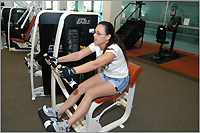| 
Faculty and Staff Sign Up for Physical Fitness
BY PAMELA MCLAREN
From Dateline (August 19, 2004)
 |
| Maria Hernandez, operations
coordinator in University Extended Education, works on
her abdominals during a session of the Employee Wellness
Program in the Kinesiology and Health Science Building.
Miyahara was one of the inaugural class of participants
in the program last spring. “They seem to really
care for your health and optimize your health awareness,”
she noted. “That’s really wonderful.”
Both the spring and the summer sessions had about 90 participants
attending sessions offered at noon and after 5 p.m. The
fall session kicks off Aug. 23. |
|
 |
Waistband a little snug after a summer of
barbecue and ice cream? Wishing that you had the time for a workout?
A solution may be just footsteps away from your office.
Established last spring, the Employee Wellness Program
offers university faculty and staff members the opportunity to participate
in a variety of physical activities and health-related fitness assessments.
But that is only a small portion of the overall program,
according to William C. Beam, associate professor of kinesiology
and health science. Eventually, he says, there will be classes,
workshops, lectures and consultations on such subjects as nutrition,
stress management and smoking cessation.
“Our goal is to become a comprehensive program,”
Beam says. For about 10 years, the Division of Kinesiology and Health
Science has sought a way to offer faculty/staff such a program.
The addition to the Kinesiology and Health Science Building offered
a facility – the 5,000-square-foot Lifespan Wellness Center
– to kick into action the fitness portion of the wellness
program.
The fitness program is offered as classes, says Beam,
to get people to think of it in the same way as an academic course
– that there is an expectation of attendance and to develop
relationships. “A big part of offering it as a class is that
it gives participants some responsibility and ownership to come.”
“It’s a great thing in terms of morale,”
says Diane Clemens-Knott, chair and professor of geological sciences,
who adds that it’s a way of connecting with others beyond
the office. “I’ve seen people that I met when I first
came on campus but haven’t had the opportunity to see much
of since then.”
So far, the program has operated with a steady core
of about 60 individuals who signed up from the very beginning and
have remained. Each session – spring and summer – have
had about 90 participants total.
“It’s such a convenient location –
just steps from my building,” says Susan Lasswell, director
of information technology administration and communications, who
works in the Pollak Library. “It’s hard to have an excuse
to not go there.”
Bill Gayk, director of the university’s Center
for Demographic Research, agrees about the convenience, as well
as the state-of-the art resistance and cardiovascular exercise equipment.
“I’ve participated in other employee fitness programs
and they’ve had really old equipment – sometimes donated
by the employees themselves.”
And like other participants in the program, he likes
the flexibility of being able to switch days or times when something
comes up. “I’ve tried to work out before or after work
and found that the only time that really works for me is noon. But
if I can’t make it then, I can go in at another time or another
day.”
Participants can sign up for 10-week courses in strength
and conditioning, women’s workout or stability ball. The one-hour
sessions – limited to 30 individuals – are offered during
each semester and through the summer and held on Monday-Wednesday
or Tuesday-Thursday schedules. Open hours are held on Fridays.
“It works well with my time,” adds Michael
Riley, media production specialist in University Extended Education.
“I feel better by going, and I get positive vibes every time
I go. I can’t say enough about it.”
Participants set their own pace and goals with the
guidance of graduate students majoring in fitness training.
“I think the kinesiology department is smart
to offer the program,” says lead electrician Spencer Colman,
who admits he didn’t have the motivation or drive to go to
an off-campus fitness club after work. “It provides a means
for employees to stay fit or improve their well-being – physical
fitness is usually a factor in employee productivity – and
at the same time provides student training. Everyone supports and
encourages everyone else to keep at it.”
Beam says that the program has a three-fold purpose:
wellness of the campus community and promotion of healthy life-styles
and choices; a source of research for faculty members; and a way
to train kinesiology students.
“I think it has really raised awareness of
fitness on campus,” adds Lasswell.
Fall courses kick off Monday, Aug. 23. For more information
on the program, go to http://hdcs.fullerton.edu/ewp.
« back to University
News
|